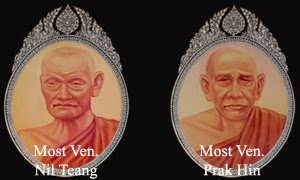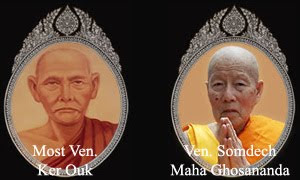
In the year 238 B.C Emperor Asoka King had sent two lear ned Bhikkus namely Sona Thera and Utara Thera to propagate Buddhism in Suwanaphumi or Southeast Asia in present time. From that time Buddhism has flourished through out the land of Suwanaphumi, especially we could note the main events in various ancient kingdom i.e.Funan Kingdom(first state of present Cambodia) has been claimed about the advantage of Buddhism in this capital city. Among the kings of Funan dynasty, Kaundinya Jayavarman (478-514 AD) sent a mission to China under the leadership of a Buddhist monk named Nagasena from India. During the reign of the same Chinese emperor, two learned Khmer monks Sanghapala Thera and Mantra Thera of Funan went to China in the early years of the sixth century AD to teach Buddhism and meditation for the emperor of China. Bhikku Sanghapala had translated a important Buddhist scripture Vimutti Magga(the Way of Freedom) which they believed that older than Visutthi Magga(the Way of Purity) of Buddhagosacara. Now this scripture has only Chiness language and many Buddhist countries have translated into their own language.
King Rudravarman (514-539 AD) is said to have claimed that in his country there was a long Hair Relic of Lord Buddha for his people to worship. The Tharavada with Sanskrit language flourished in Funan in the fifth and earlier part of the sixth centuries AD. Around seventh century AD, the popular usage of Pali language in southern region suggested the strong appearance of Theravada Buddhism in Cambodia.
The great emperor, Yasovarman (889-900 AD) established a Saugatasrama and elaborated regulations for the guidance of this asrama or hermitage, at the time, Buddhism, Brahmanism(both Visnuism and Vaisnavism) flourished in Cambodia. During the reign of Jayavarman V (968-1001 AD), the successor of Rajendravarman II, Mahayana Buddhim grew in importance. The king supported Buddhist practices and invoked the three forms of existence of the Buddha. In this way, up to the tenth century AD, Mahayana Buddhism had become quite prominent.
Pramakramabahu I, the king of Sri Lanka, is said to have sent a princess as a bride probably for Jayavarman VII, son of Dharnindravarman II (1150-1160 AD), who was the crown prince. King Jayavarman VII (1181-1220 AD) was a devout Buddhist and received posthumously the title of Mahaparamasaugata. The king patronized Mahayana Buddhism, his records express beautifully the typical Buddhist view of life, particularly the feelings of charity and compassion towards the whole universe. Taprohm Inscription of his informs us that there were 798 temples and 102 hopitals in the whole kingdom, and all of them were given full support by the king. One of the monks who returned to Burma with Capata Bhikku was Tamalinda Mahathera, who most probably was the son of the Cambodian King Jayavarman VII. Under the threat of flowing of Sihala Buddhism; his prestige diminished, his temporal power crumbled away, and the god-king worshipping was concealed. Theravada Buddhism had become the predominent religion of th people of Angkor by th end of Jayavarman VII 's reign.
The second half of the twelfth century AD, Sri Lanka's fame as the fountain-head of Theravada Buddhism reached the Buddhist countries of Southeast Asia. The knowledge of Sinhala Buddhism was so wide spread and the Sinhala monks were so well-known to the contemporary Buddhist world. At this time a Cambodian prince is said to have visited Sri Lanka to study Sinhala Buddhism under the able guidance of the Sinhala Mahatheras. Buddhism continued to flourish in Kambuja in the thirteenth century AD but yet to become the dominant religious sect in the country. After then, Theravada becam the main type of Buddhism. The change was undoubtedly due to the influence of the Thais of Thailand, who were ardent Buddhists and had conquered a large part of Cambodia land. Under the influence of the Thais, Sihala Buddhism was also introduced in Cambodia. With the passage of time, the Brahmanical Gods like the Angkorean Period were replaced by Buddhist images. Gradually, Buddhism became the dominant creed in Kambuja and today there is hardly any trace of the Brahmanical religion in the country, though had mixed like the people folk belief.
The Jinakalamali gives an account of the cultural connection between Cambodia and Sri Lanka in the fifteenth century. It states that 1967 years after the Mahaparanibbana of Lord Buddha, eight monks headed by Mahananasiddhi from Cambodia with 25 monks from Nabbispura in Thailand came to Sri Lanka to received the Upasampada ordination at the hands of the Sihalese Mahatheras. Buddhism continued to flourish in Cambodia in the sixteenth century AD. King Ang Chan (1516-1566 AD), a relative of king Dhammaraja, was a devout Buddhist. He built pagodas in his capital and many Buddhist shrines in different parts of Cambodia. In order to populize Buddhism. King Satha (1576-1594 AD), son and successor of Barom Reachea, restored the great third floor of Angkor Wat(in the past was erected and dedicated to the God of Visnu), which was built by King Suriyavarman II (113-1150 AD), had become a Buddhist shrine or Buddist Temple by the sixteenth century AD. During the seventeenth and eighteenth centuries, Thailand's interfarence in Cambodia's politics helped the former to influence the religious world of latter.Though Thailand disturbed Cambodia's politics and hampered its progress but the Thai kings and their Buddhist world made a distribution to the progress of Buddhism in Cambodia.
Under the controlling of French (1863-1954 AD) Buddhism in Cambodia had developed by the hard works of monks in temples. Frence has had less giving chance to Cambodian people to study in higher grade or they give chance them to study only as the translators for them. Especially monks are damned by French colonist. While French try to uproot Khmer literature and culture, Khmer monks to against them by openign schools in every temples.
After getting liberation from Frence Cambodia Buddhism grew up again under the patronized of King Norodom Sihanu. His Majesty the King has been asking the assemply to include Buddhism as the state religion. In that time Cambodia has had many Buddhist Scholars such as Somdech Choun Nat, Somdech Hout Tat, Pang Khat and Kiev Chom...as the active leaders of developing Buddhism in Cambodia.
In 1975 AD when the communists took control of Cambodia they try to completely destroy Buddhism and very nearly succeeded. By the time of the Vietnames invasion in 1979 AD nearly every monk and religious intellectuals had been either murdered or driven into exile, and nearly every temple and Buddhist library had been destroyed.
Today Buddhism is struggling to re-establish itself although the lack of Buddhist scholars and learned leaders and the continuing political instability is making the task difficult.
However, we optimistically believe that Buddhism in Cambodia would gradually grow up to its glorious again. As nowaday, the administrative of religion of Cambodia we have the ministry of Religion and Cult Affair. We have the Buddhist institute for researching Buddhist scripture. And the constitution of Kingdom of Cambodia have put Buddhism as the state religion in article 43 "Khmer citizens of either sex shall have the right to freedom of belief. Freedom of religious belief and worship shall be guaranteed by state on the condition of such freedom does not affect other religious belief or violate public order and security. Buddhism shall be the State Religion" And the government support the study Buddhikaseksa of monks as has confirmed in the constitution in article 68 "the state shall provide primary and secondary education to all citizens in public school. The state shall disseminate and develop the Pali school and the Buddhist Institute".





0 comments:
Post a Comment